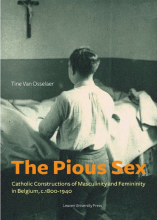
Although women were called the “pious sex” much earlier, it was during the nineteenth century, when the differences between men and women were being made more explicit, that an intense bond between women and religion was developed. Religiosity was thought to be a “natural” part of femininity and turned religious masculinity into an oddity. This clear-cut gender ideology, however, remains an ideology (prescribed and contested) that needs to be put in the perspective of its context of origin, the bourgeois milieu. How were these gender identities constructed and by whom? Tine Van Osselaer seeks to clarify how the gender differentiation was created among Belgian Catholics. She brings to light the extent to which religiosity was inscribed in these constructions and how religious teachings contributed to it. It is clear that the limitations of the “feminization” thesis, a master narrative that has strongly contributed to the introduction of women in religious history, have gradually become more visible. Documenting pastoral care, the devotion to the Sacred Heart of Jesus and Catholic Action, this book offers critical commentaries on the master narratives, suggesting that even men could belong to a “pious sex".
